Text
The Devil’s Candy (USA, 2016)

Well, heavy metal has never had such a good advertising campaign. There’s a lot of things that are a little silly about THE DEVIL’S CANDY, a new possession/home invasion movie that takes very seriously the idea of a satan that wants you to do some absolute guitar shredding in his name, but overall, it’s more a chance to say, “Hey, metalheads are people, too!”
The film is bare-bones simple: A guy who hears satanic voices kills his parents, leaving the home into which he just was released open for the purchase. A metal-loving family led by Ethan Embry and UnReal’s Shiri Appleby snap up the place, mostly because it gives Embry’s painter a giant space in the back to paint (he’s a muralist), and their daughter covers up the teddy bears on her wall with hardcore band posters. Soon, Embry’s painter is getting inspiration from a demonic muse, forgetting his daughter after school, and the whole family is fighting off the presence of the former tenant who killed his parents.
Did I mention the part where Ethan Embry is a heavy metal painter? This is a very entertaining film in many ways, despite the fact that it doesn’t actually do much to scare you or make you care about the characters or...well, much of anything, really. We immediately have sympathy for this family because they’re metalhead dorks with money troubles, but honestly, it’s not much more than the average Hollywood ‘Save the cat!” approach to caring about protagonists.
The interesting part, as always with horror, is what the film signifies. Strip away the supernatural part, and what you’re left with is the actual story. In the case of The Devil’s Candy, that means a narrative in which a struggling family moves into a new place, and the wannabe-artist father immediately pays them less attention, adapting to his new circumstances by ignoring his daughter and wife. It doesn’t really go anywhere, but it does pay tribute to the notion of how families’ economic troubles dictate their success far more than most other factors.
Again, not that scary, not that cool, but weirdly, Embry and Appleby make the film deeply watchable, compensating for the milquetoast storyline by providing maximum relatability and endearing-ness. Sometimes, a film requires little more than a few good actors and a justification for its plot. The Devil’s Candy reminds you that any family can fall victim to money troubles, and that such a problem is all that’s required to upend even the most loving family.
1 note
·
View note
Text
Cold Prey 2 (Norway, 2008)
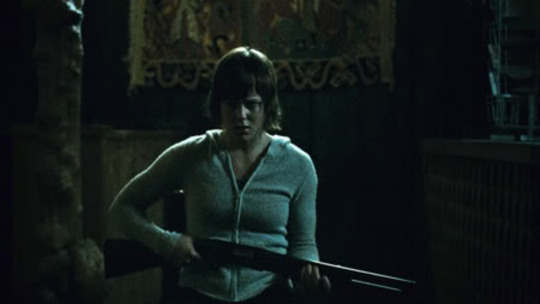
Sequels to slashers are notoriously difficult. Without a sharp left turn, stylistically speaking, all you can really do is rehash the beats of the first one, only...more so. It’s a losing game, as evidenced by nearly every single slasher sequel in the history of the universe. Halloween 2, Friday The 13th Part 2, I Still Know What You Did Last Summer; without some clever innovation a la Texas Chainsaw 2 or fun allegorical subtext like Nightmare On Elm Street 2, it’s hard to create any new magic for a formula and recipe that’s been seen before. The subgenre is mostly based on the opposite of character development, so when you’ve got your strategy, it turns into capitalism at its purest: innovate or perish.
Cold Prey 2 splits the difference by following almost exactly the same recipe as Halloween, meaning it tries to hew to what made that sequel (somewhat) work, despite providing very little in the way of new scares. Still, horror is wholly a director’s game, where structure, framing, composition, and editing are nearly 100 percent responsible for any fear instilled in the viewer, and since Roar Uthaug returned from the first installment to deliver more chills, it’s slightly more of a success than the non-Carpenter-helmed Halloween 2. This isn’t to say it’s some great achievement, and Lord knows it has its share of forehead-slappingly dumb moments, but it also benefits from the steady head of a director who knows what they’re doing.
Ingrid Bolsø Berdal reprises her role as Jannicke from the first film, the sole survivor from the reign of terror in which her group of friends spent the night in an abandoned Norwegian hotel and systematically died at the hands of a masked murderer. It ended with her slamming a pickaxe into the bad guy and kickinghim into the bottom of a ravine, so naturally, this movie has to include a belabored explanation for how he could’ve survived such a thing. It’s not terribly convincing, so we all just move on, but still, you’d think someone would have taken a moment to do the math, here. Once he’s taken to the same hospital as Jannicke—a minimally staffed place that’s closing in mere days, thereby justifying the less than half-dozen staffers on hand—he gets a resuscitation scene, and from there on, it’s a steady game of assassination as we watch him tease out and kill nearly every character. In a rare change of pace, the movie actually ends pretty definitively, which is probably why Cold Prey 3 is a prequel.
What works is Uthaug’s commitment to playing with conventions of the genre, as moments that should end in jump scares instead segue into weird transitions, and horrifying confrontations with the apparently undead monster conclude with abrupt deaths. In a movie wherein the main antagonist has already revealed himself in just about every form imaginable, there are still somehow a few surprises. There’s not much tension built, but there’s a hearty sense of play at work in the execution, which goes a long way when your genre position is historically known for a lack of changing up the game.
This isn’t to claim Cold Prey 2 is a must-watch, or even a “Hey, you’re hungover on a Sunday, probably check this out.” What it is is a reliable delivery system for what you’re expecting, a lighthearted and grisly Rube Goldberg-esque death trap of chest wounds and last gasps. The characters are likable, which is a leg up in this field, and it’s a fleet experience that delivers the goods and gets out before it wears out its welcome. I’m sorry there’s not more to report, but we all know what we’re getting into with a film like this. Go Norway—this is your rare cinematic chance to shine.
2 notes
·
View notes
Video
Attack of the Killer Donuts Trailer : Yep, this is happening.
0 notes
Text
Review: Rabies (Israel, 2011)
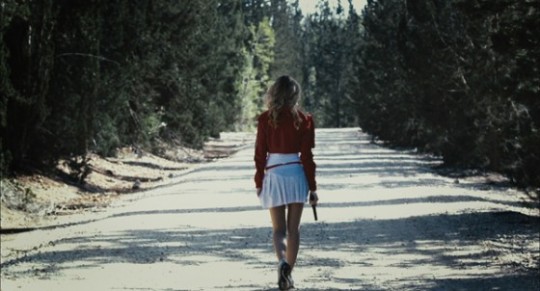
Horror films are expected to deliver certain qualities, primary among them being some scares. Rabies (Kalavet in the original Israeli) is not only unique for being the first horror film produced in Israel, but for upending just about every expectation for slasher films. It’s a movie that constantly surprises the viewer, pivoting from tension to the bleakest humor on a dime, and refusing any commitment to “scares,” if by that word we mean causing someone to become fearful. Apprehension, yes. Scary? Not so much, but—and this may be the only time I ever say this—in the best possible way.
The movie tells the story of four interlocking stories, but not in some trite, overly simplistic Crash-meets-Babel kind of way. No, Rabies tells the story of a runaway brother and sister, a group of tennis players who get lost en route to a match, a pair of emotionally unsound cops, and a state park evaluator and his dog. Oh, and a serial killer, let’s not forget about him. These people all wind up, through pure happenstance, in the same remote forest at the same time. And prepare to feel like a particularly click-bait-y site is writing this review, because what happens next may surprise you.
Writer-directors Navot Papushado & Aharon Keshales have repeatedly said their film is an allegory for the political situation of their country, and it’s not hard to see that once the blood begins to run. But, as is the case with many horror allegories, it gets a lot more interesting once you go past the overt intent and look at what’s beneath. I would strongly recommend this film to any horror aficionados, before I launch into the standard spoiler warning. Go see the movie, then come back and let’s talk.
...Okay. I can honestly say I’ve never before seen a horror movie in which the ostensible maniac killer is knocked unconscious in the first act, and spends the entire film out of commission. It’s a brilliantly unpredictable, one that frees up the movie to deal with its real subject, namely, the latent violence hiding within everyday people. Once the supposed murderer is waylaid, Rabies unfolds with the force of its conviction—specifically, the idea that violence begets violence, and humans (especially male humans) are hardwired to escalate tense situations past the point of repair. One of the cops turns out to be a sadistic maniac, much more disturbing than any killer. The two male tennis players turn on each other, The brother, thinking he’s rescuing his sister, ends up killing the benevolent guy trying to help her. The girls kill in self-defense, but the psychological toll of the violence shreds their emotional capacities to handle the situation. One dies needlessly and senselessly in a literal minefield. By the end, the only ones left are barely functional, save for the killer, who wakes up frustrated and angry that his fellow countrymen aren’t coming to his aid.
Take Night Of The Living Dead and double down on the philosophy and black comedy, and you’re getting somewhere close. Well played, Rabies. Well played, indeed.
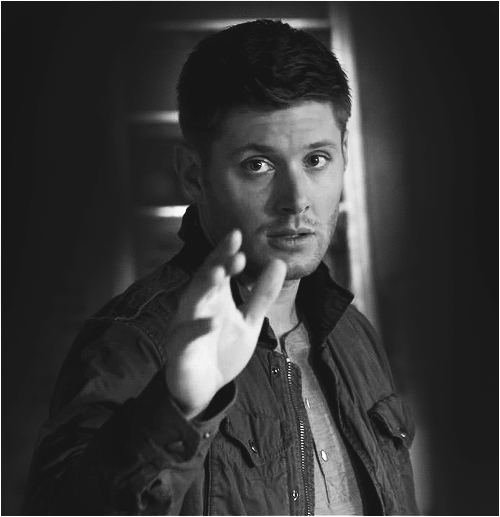
If I were to get into the psychoanalytic meaning of the film, I’d start talking about Lacan’s sinthome, but in the interest of clarity, let’s talk about how this movie shows the impossible kernel at the heart of violence. People act in ways that are completely unbelievable, and yet track perfectly with the impossibility actions of reality. There are moments when you can’t believe how insane nearly every character behaves, but it never feels outside the realm of human potential. Horror has always excelled at demonstrating the failings of the human psyche, but Rabies gives those failings a twist, separating them completely from any malevolent forces outside ourselves, and placing the blame squarely at the audience. In that sense, it’s more like a wittier version of Michael Haneke’s Funny Games: a film wherein the rules of not only the genre, but cinema itself are twisted, reworked to convey something darker about the nature of our lesser angels. Plus, it’s far from hectoring; Rabies is smarter and sharper than most slasher films, while being darker than nearly all of them.
The title suggests something infectious, the way that violence can be transferred from person to person, once they’ve experienced it. It fits smartly into the filmmakers’ vision, and provides a neat counterpoint to the standard horror thesis that we are only moved to violence by horrific forces outside our control. Papushado and Kushales invert the standard narrative, and in the process offer some exciting and tense cinema, that gets the pulse racing precisely because it continually zigs where you expect it to zag. Once we’re touched by violence, it doesn’t force us outside our comfort zone. It leads us to what we already have designs on. Bleak, yes—original? Absolutely catching.
0 notes
Link
This looks terrifying.
31 notes
·
View notes
Text
Starry Eyes (USA, 2014)
youtube
The idea of sacrifice has always been a potent one in horror, perhaps because we all can relate to the idea of undergoing some painful or stressful process in order to get something we want. Much like those studies showing how people who luck into large amounts of money or high-paying jobs quickly come to believe they’re more deserving of it than other people, people who have sacrificed something to get ahead will immediately believe there was no other way to achieve their goal. This isn’t necessarily a bad thing—plenty of good things don’t come without hard work and sacrifice, after all—but we all innately believe there’s a certain line that shouldn’t be crossed, even if we can’t agree on where that line is. For you, it might be hurting someone else to get what you want; for another person, maybe taking a gig purely for the money feels inappropriate. Luckily, Starry Eyes is well aware that we all probably draw the line at murder. (And if you don’t, please never approach me.)
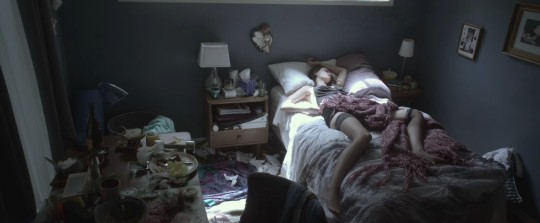
A film that deals with the psychological effects of putting personal gain above all else, Starry Eyes is remarkable, and not just because you get to watch a girl vomit up live worms. The movie tells the story of Sarah (an impressive Alex Essoe), another in the endless procession of hopeful young actors trying to make it in Los Angeles. Instantly familiar without becoming a stereotype, Sarah navigates the normal casting calls, embarrassing paying-the-bills day job, and emotional insecurity of an industry where your total worth is evaluated (and usually discarded) in a heartbeat. Soon, however, a chance encounter with a casting agent in a bathroom lands her a plum audition for a lead role in “The Silver Scream,” a serious movie by a reputable production house. Sarah is offered the part, but only via the humiliating and degrading casting-couch maneuver: she has to sleep with the wizened producer to get the job. She initially refuses, placing her self-worth above that of a sex-for-a-job trade-off. But returning to her regular life feels like more of a failure than she can handle, and soon Sarah is back at the producer’s house, where it turns out getting the role is going to cost her a lot more than just a night of unpleasant sex. Cue the black-robed cultists, the physical changes, and the aforementioned worm-vomiting. Starry Eyes offers all that and more, a veritable smorgasbord of bodily and psychological horror.
The movie is well worth your time, a sumptuous character study of a fracturing mind, but the real rewards lie in the philosophical underpinnings of the story. Soon after she’s granted the role that will supposedly vault her into stardom, Sarah begins feeling sick, and calls her new producers in a panic. “Did you think it was going to be easy?”, the voice on the other end of the line asks. The fame and fortune that she craves, the stripping away of her old life en route to a newer and better one, isn’t something that simply falls into her lap, he says. There are serious, and painful, consequences. And while the film’s version of these consequences are ten times more horrifying than the usual process of acclimation for the newly minted famous among us, each step of Sarah’s gradual transformation rings eerily true. The gradual severing of the old life—old friends, old places, and especially old mentality—here takes on physical characteristics, as our protagonist begins to literally change, not just psychologically.
Each of us has made a similar change at some point in our lives, where we cast aside an old life and began a new one, even if it didn’t feel quite so transformative at the time. Going away to college, moving to a new city, starting a new job... each of these can often be the impetus for a new phase of our lives, with new friendships and new understandings about ourselves that color the future choices we make. And these transitions are rarely without growing pains, often in the form of losing touch with old friends or becoming different people in how we view and interact with the world. We hope for the best with these changes: ideally, we’d like to grow and become better people, learning from past mistakes and maturing with experience. But it’s easy to look around and see that the reverse is equally plausible. How many friends of yours have ended up in jobs or relationships that don’t seem to have done them any favors, personality-wise? But if you asked them about it, they certainly wouldn’t cop to being shallower, or meaner, or more self-serving than they were in the past; in their minds, the new circumstances dictate new behaviors and attitudes, even if the justification was retroactive. Changing almost always feels like maturation to the person undergoing it, even if it looks to the rest of the world like they’re taking a giant step backwards.
Starry Eyes takes these painful adjustments and renders them terrifyingly literal. Sarah is actually becoming a different person, and it’s not fun or easy. The movie depicts her relationships with fellow female actors as an uneasy bond of ostensible support, shaded with psychological undermining and passive-aggressive emotional abuse hidden as concern. The guys, by contrast, are shown to be filmmakers and camera-men, their gaze always subtly altering the frame of the situation. The movie is smart enough to allow these hoary stereotypes to operate as a sort of auto-critique of patterns and social pecking orders that many of us unconsciously allow ourselves to fall into, even as we overtly rail against them in our politics or our lifestyles. I can’t recall the number of times I’ve been at a dinner table where one or two men ended up monopolizing both the conversation and the social space, even while loudly touting their progressive bona fides. The rest of us let it happen not because we’re okay with structural sexism, but because we were polite; we didn’t want to create an uncomfortable situation, let alone make ourselves the center of attention by trying to wrest the setting away from its dude-bro conventions. The movie slyly suggests that such attitudes will eventually have unpleasant consequences for those who participate in them, regardless of good intentions. Let’s just say Sarah eventually has to stop emotionally cutting her old gang out of her life, and instead actually cut her old gang.
The movie is filled with sharp and funny performances—it’s not all bleak nightmarish visions and edge-of-your-couch tension. Character actor superstar Pat Healy appears as the boss at Sarah’s waiting tables job, a well-intentioned guy who nonetheless degrades her in his own way. Noah Segan turns in a nicely honed portrayal of Danny, the nice guy who just doesn’t get it, and lets her down when push comes to shove. In perhaps the starkest example of a fair-weather male friendship, when Sarah gets ill and begins behaving erratically, her friends decide to let her walk it off by herself, not exactly the gesture of empathy one would hope for. Danny exhibits concerns, and turns to Sarah’s roommate, Tracy. “What’s wrong with you, she’s sick!” he says, raising our hopes. “Go after her,” he then tells Tracy, immediately reminding the audience that even nice guys often see caring for others as important, as long as it’s someone else’s job.
Of course, it’s a horror film, and the movie isn’t all subtle character study and deconstructions of sacrifice and gender. Directors Kevin Kolsch and Dennis Widmyer also deliver terrific entertainment, grim and unsettling. The body horror is worthy of Cronenberg himself, and there’s a winking homage to Rosemary’s Baby near the end that brought a smile to my face. Sarah’s breakdown moves along at a solid clip, pausing just long enough to register the emotional beats of the characters before launching itself into another creepy, slightly surreal nightmare. It’s a great horror movie, flexible enough to be crackerjack Saturday night midnight-movie manna or a thoughtful arthouse conversation fodder. It’s one of the better horror films of the past year, and further evidence that indie horror is crushing it these days. Did we mention the part where she barfs up worms?
#somethingbooo#horror#starry eyes#alex essoe#pat healy#psychological horror#body horror#david cronenberg#kevin kolsch#dennis widmyer
3 notes
·
View notes
Text
Review: The Taking Of Deborah Logan (USA, 2014)

As the found footage genre ages, it's naturally hitting some growing pains—the kind of thing that you would expect from one of the few genuinely new forms and structures of cinema to develop in the last couple of decades. Once the format became widely reproducible, so that anyone with a couple grand could make their own horror movie on a level with mainstream releases like Paranormal Activity, the floodgates were opened, and we horror fans were absolutely drenched. While I understand many people's exhaustion with the format as a result, I tend to believe that this is more a result of overexposure; if I got a sunburn every time I went outside, I might start resenting the sun.
The Taking Of Deborah Logan, for what it's worth, doesn't cut in any reaction shots, the way some other laughable entries in the genre have as of late. (looking at you, The Pyramid.) Neither does it try to ignore the fact that someone has assembled this footage together—sure, they don't tell you WHO, but at least they gesture towards acknowledging the structure they're working with. It feels like the barest nod, but it's something.
The film does something I haven't seen many other films outside of Away From Her deal with: the slow, painful loss of a loved one to Alzheimer's, only using the conventions of horror to explore the psychological toll it takes on those left to care for the victim. In this case, Mia (Michelle Ang), a PhD student doing research on Alzheimer's sufferers and their families, has been given a grant to make a short film looking into the life of someone with the illness. By our good fortune, it happens to be with a woman who just may be dealing with the spirit of a demonic serial killer. Way to go, Mia.
Arriving at Deborah's house with a two-man film crew, Mia, cameramen Luis, and tech guy Gavin meet Deborah and her daughter, Sarah (Anne Ramsay), who travels here from her residence in the city to care for her ailing mother. Deborah needs the money from Mia's grant to cover medical costs and allow her to stay in her house. The film does an excellent job of illuminating these very believable women and their rather difficult lives. Sarah is the consummate daughter—helpful, frustrated, sick to death of the situation, and drinking a bit too much to help her cope with the emotional toll. Deborah would rather no one assist her at all, and does her best to minimize her illness. However, over time, it becomes clear that something else is going on, as well. While Deborah's illness progresses, things begin to happen around the house, leading the crew to suspect there's more going on than meets the eye. Soon, Sarah is convinced a supernatural force has infected her mother, and she wants to solve the mystery before it subsumes Deborah completely.
The film does a lot right. It has a few genuinely tense moments, often the result of the intermingling of Deborah's illness with the possibility of something more. The psychological effect of just her encroaching Azheimer's is a brutally scary thing—it's a wonder someone hasn't done this story before. It's such a crushing ailment, it's too perfect for horror, really. The script is solid, with believable characters, solid performances, and a potent central conceit. Yay, The Taking Of Deborah Logan! You did these things right.
What doesn't work? The direction. This feels very much like a first-time filmmaker, as there are a number of rookie mistakes on display here. The primary failing is the mistaken notion that jarring, disorienting camera work, where you can't follow what's happening, contributes to the scariness. It does not. It stops the tension in its tracks. One of the smartest realizations the Paranormal Activity folks has was that steady camera work—the inability of the camera to turn away, that it will document what's in front of it—can create an aura of almost unbearable tension. Whereas having your most active moments of action suddenly get buried beneath a wildly swinging, chaotic camera means that most of the excitement drains out of the viewer, who no longer has to pay attention because there's nothing to see. Saying, "But it's found footage—the person holding the camera would DO that!" is a cheap cop-out. Don't make the film if you're not going to make it well. Characters might also be dumb, but the actors playing them still have to portray them intelligently. Your camera is a character, and new directors, horror or not, forget that at their peril.
Also, free tip: do your homework. If one of your characters is a doctor, who's going to be saying doctor-y things, make sure you know what kinds of things they would say. To have two doctors talking, and one of them say, "These are all the classic hallmarks of split personality disorder," as happens in this film, pulls viewers right out of the movie. Why? Because that is not a term doctors use any more. Period. It sounds like they're imitating a doctor from the '50s. Similarly, if you've got a professor who's a PhD in history, don't have him talk about how "belief of spiritual parasites exists among many thousands of cultures." Why? Because there aren't many thousands of cultures. You're off by a figure of many thousands. It hurts my soul. Lastly, remember that your characters are supposed to be making decisions that make sense to them, even if they make seem rash or unnecessary to the audience—they still have to seem like a choice someone would make. So when, for example, a guy is about to smother a hospital patient with a pillow, it's a good bet he wouldn't undo the straps pinning down her wrists. Unless he has a strong desire to be thwarted in his plan, which, yeah, he really doesn't. Little things.
But thus endeth my nitpicky criticism. Really, this is the definition of a "grower": there's so many things it does right, I just wish I could have seen the film as it could be in the hands of a more sure-footed director. The Taking Of Deborah Logan is a four-star story and cast stuck in a two-star film. There's tons of potential, and I hope to see forward progression in the next outing by this team.
0 notes
Photo
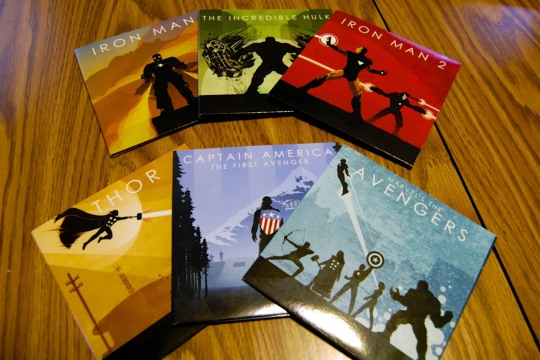



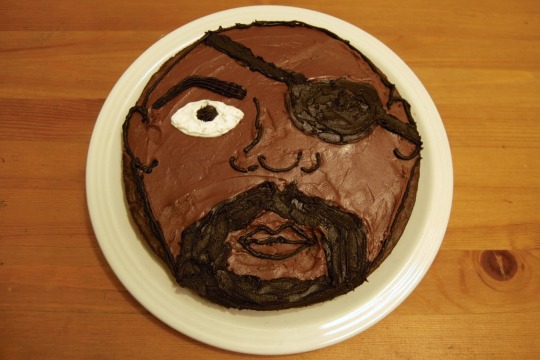


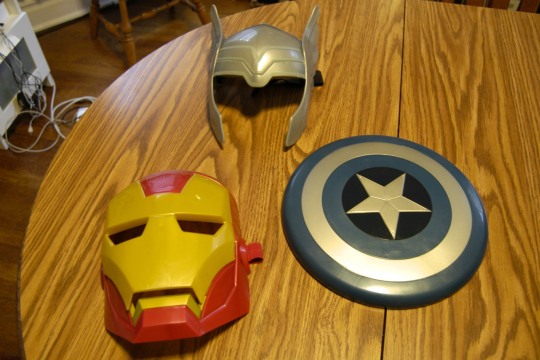

Marvel Movie Marathon
After Captain America: The Winter Soldier awakened my inner Marvel fangirl, I enlisted two of my comic-loving friends to take on an epic Marvel movie marathon. All told we watched Iron Man, The Incredible Hulk, Iron Man 2, Thor, Captain America, The Avengers, Iron Man 3, Thor: The Dark World, Captain America: The Winter Soldier, and Guardians Of The Galaxy.
For the uninitiated, Marvel Studios has a unique “cinematic universe” (the MCU) in which all 10 of their movies exist in the same interconnected world. When our planned 20+ hour marathon turned out to be a little too ambitious, we decided to split the marathon across two days. My friend Ned brought us awesome Avengers props and Hulk-themed beer, my friend Alex contributed enough BBQ to fuel a full superhero team, and I provided an Avengers-themed menu of snacks (see the full thing here) including a Nick Fury cake that might be the greatest achievement of my life. We kicked things off at 9 a.m. with Captain America themed bagels and managed to fit in seven movies during our first day.
Here’s what I learned:
Now that I understand it I like the MCU a whole lot, but it hasn’t surpassed X-Men as my favorite superhero franchise.
Captain America is far and away my favorite Avenger, in fact he might be one of my all time favorite superheroes. I love that Steve Rogers is an underdog with the heart of a superhero who becomes a superhero with the heart of an underdog. The way he challenges the system while working within it is hugely inspiring to me.
The only MCU movies I hadn’t seen before the marathon were the first two Iron Man films and The Incredible Hulk. I was a little less impressed with Iron Man than I wanted to be, but I liked Hulk way more than I thought I would.
I remain relatively unimpressed with Guardians Of The Galaxy.
I finally understand who Thanos is.
Guardians Of The Galaxy's delightful pop culture references make zero sense when you remember Peter Quill left Earth as a small child. How the hell does he know who Jackson Pollock is?
For the life of me, I can’t keep track of which objects are Infinity Stones and who currently has them.
Chris Hemsworth is ridiculously charming and Thor wouldn’t work without him.
In the MCU, Oscar-winning actresses like Natalie Portman and Gwyneth Paltrow are reduced to the girlfriend roles. Paltrow at least gets some interesting stuff to do as CEO Pepper Potts but Portman’s Jane Foster is really underutilized.
I was initially disappointed with the way Iron Man 3 wrapped up Tony’s PTSD storyline, but Alex convinced me that it works far better than I was giving it credit for.
Winter Soldier is best enjoyed as a rom com starring Steve Rogers and Sam Wilson, with Bucky Barnes as the ex who unexpectedly returns to stir up drama.
The Marvel one-shots are a whole lot of fun.
Loki doesn’t get interesting until The Avengers and in fact makes little sense as a character in the first Thor.
Edward Norton and Liv Tyler are the best couple in the MCU.
Avengers and Winter Soldier are tied for my favorite film.
My favorite scene is when little Steve jumps on the grenade. I cry just thinking about it.
If you want to read my writing on the MCU, check out my A.V. Club piece, Unfortunately, The Winter Soldier was the best female-driven superhero film of 2014.
22 notes
·
View notes
Text
BEST OF 2014: TARDY EDITION

The second half of this has been a long time coming—blame it on the amazing amount of great stuff we got last year! (Definitely that, and not my own blown deadlines, for sure.) Anyway, he already started posting the best of 2014 scary stuff, but today we finish it off, with great recommendations from anniewu, LYLE director Stewart Thorndike, operator of Roaratorio Records' James Lindbloom, and others! Oh, oh, it's magic. On to the upvotes for the spookiest of last year, which you should seek out past-haste:
STEWART THORNDIKE, director of the superb LYLE (which we reviewed here): See BABADOOK and you'll want more women to take over horror. Depression is a monster and Jennifer Kent knows just how to tell a story about living with demons. My favorite Netflix horror find this year was SESSION 9 by Brad Anderson. It's got a great tone -- some of the 70's realism I long for in my horror.
JAMES LINDBLOOM, head of the superlative Roaratorio records: The best new horror movie I saw this year was UNDER THE SKIN. I suppose it's technically more science fiction than horror, but the soundtrack -- and the overall sound design itself -- made it a genuinely unsettling, creepy, and scary movie, moreso than any new straight-up horror genre effort that crossed my path in 2014. Although the award for "most frightening movie I saw in 2014" would have to go to THE ACT OF KILLING.
ANNIE WU, illustrator on HAWKEYE and BATGIRL BEYOND, two comics you should be reading: I went on a classic British horror/thriller tear earlier this year, and part of that included the original THE WICKER MAN (1973) starring Edward Woodward and Christopher Lee in a series of horrible hairstyles. Although the dread factor is high, the real weirdness is how every conversation about this movie doesn't start with "holy crap, it's actually a musical." I was so on board. I mean, it's no Fosse, but you get stuff like maypole numbers and Britt Ekland jamming to "Willow's Song" so that's pretty crazy. Won't someone please take this to Broadway?
KATE SILVER, writer extraordinaire: After watching STIR OF ECHOES (1999) on my couch in the dark I woke up with faint voices in my head — which could be credited to the whiskey we were drinking. This is a true basic-cable score. The horror-thriller-whodunit, directed by David Koepp (writer of PANIC ROOM) has great pacing, creepy music and a real surprise ending. Plus! It reunites PICTURE PERFECT’s Kevin Bacon, Kevin Dunn and Illeana Douglas.
ADAM WATERMAN, academic and cultural critic: I think the only horror film I watched this year was PARANORMAL ACTIVITY 3, and what was truly horrifying about that was that I was in Montreal on the world's worst date, and my partner spent most of the movie on his Grindr profile.
MATT HELGESON, senior features editor, Game Informer magazine: I heard that new one the Badonkadonk is great. (Ed. note: Matt apologized for not seeing any horror this year, and then told me I shouldn't print this submission. I guess we're not quite there yet, Matt.)
SETH LIND, performer, THANK YOU, ROBOT improv comedy group: If you're seven years old, I can highly un-recommend watching THE SHINING.
PAMELA BELL MITCHELL, actress/singer: I shall shamelessly plug my own horror short INNARDS. It's gory without being 'gory', smart, and makes you really wonder what's in your 'genetically modified food'.
Otherwise, like probably everyone else said: THE BABADOOK. Sad, dark, and cold, the cinematography was perfect, as was the sparse set and color design. Also, it had an almost all female production team , which added a maternal aspect to the film, which personally I felt added to the creepiness. The editing really stood out to me, as it respected the intelligence of the audience, and made the story move in a fast and frenetic manner that isn't seen so often in horror films. I very much look forward to more from that entire team. And: WE ARE WHAT WE ARE....not from this year, but I saw it on Netflix recently and loved it. Slow and genuine, with basically unknown actors (a great reason to watch horror movies) playing really nuanced characters. The poor southern and austere world created wraps you in so quickly, and the twist and payoff in the end are allowed and even encouraged due to the slow and steady pacing leading up to the end.
MARK DOTEN, editor, SOHO Press: Dinner with friends with Brett
Gelman and friends which came out this year—an adult swim
parody of John Favreau's "Dinner for Five" that employs a bunch of
horror tropes.
That's it for now—here's to a horrifying 2015, so to speak.
#something booo#horror#best of 2014#annie wu#Stewart Thorndike#Pamela Bell Mitchell#Mark Doten#Seth Lind#Adam Waterman#Matt Helgeson#Kate Silver#James Lindbloom
0 notes
Text
Review: Big Ass Spider! (USA, 2013)

Part of me wishes I had been able to show Greg Grunberg my review of Spiders from two years ago. Something that gave an indication of low-budget movies trying to look like big-budget movies through the use of shoddy CGI. Something that represented what it looks like when you try and make a movie for very little money that wants it to look like giant, rampaging spiders are laying waste to a major metropolis. Something that he could see and say, "Oh, so that's what is going to happen. Huh."
To be fair, it's not all that bad. But that's part of the problem. You see, watching a bad horror movie has the potential to offer its own unique set of pleasures. Not quite on the level of, say, The Room, a truly bad horror movie can occasionally make magic out of the lemons it has to work with. The fun becomes taking stock of the missteps, or laughing along with the film when it realizes it doesn't have much to offer, but damned if it isn't going to try and give you its money's worth. Conversely, there's the bad horror film that is simply bad; it doesn't have the self-awareness to see what it's doing wrong, and every choice is a bummer rather than a treat. It may not offer much, but when it comes time to take stock, there's little to worry about when pulling out the long knives.
Big Ass Spider! falls squarely in between these two camps. It's a listless, clumsy, forgettable offering that fails to deliver much in the way of campy fun even as it struggles to rise above the cookie-cutter nature of its story. Anyone who has seen a '50s sci-fi slice of cheese like Them! or It Came From Outer Space knows what happens here. Our hero Alex Mathis (Grunberg), a good-hearted wiseass who runs an extermination business, finds himself in a hospital the same day a mysterious spider-like insect gets loose in the morgue. Trading his services in exchange for the cancellation of his bill, Alex begins hunting the spider, only to quickly realize that it's unlike anything he's seen before. The insect is large, growing by the hour, and killing anyone it comes across. Soon, the military arrives, led by Major Braxton Tanner (Ray Wise) and his sidekick Lt. Karly Brant (Clare Kramer)—you know, just normal old army names, no biggie—intent on destroying the spider. Of course, it's soon revealed the creature is the result of alien DNA infused with a normal deadly spider, and Alex's special skills are called upon to help them track and take out the behemoth.
You never enter a film wanting it to be bad, but very often, within minutes, one gets a sense of just what kind of film it's going to be. Big Ass Spider! tells you almost immediately that it's going to be loud, flashy, rather sloppily shot and edited, but leaning almost exclusively on its sense of campy "fun" to carry it through. The script isn't strong enough to deliver the goods in this area. There are numerous groan-worthy "jokes" that require stamina to endure. (Sample bit of humor: "First I thought it was a monkey. Then I thought it was a spider? Maybe it was a spider monkey!") When it moves into the action-based third act, the dialogue gets even worse, as it becomes secondary to trying to provide respectably-staged shots that balance visual gags and "excitement," though the quotes around that second concept may as well be applied to practically the entire film. Kramer suffers some of the worst indignities, despite obviously being game for just about anything; she has to sell a "this is my job" line that Alec Guinness would struggle though.
The script expects the witlessness of some of the story beats to be overcome by the charm of its wit and cast, and usually loses that particular gamble. The spider is shown to be immune to basically all bullets, including machine guns, grenades, and being knocked off the top of a 40-story building. Yet, when our hero's sidekick Jose (a security guard from the hospital, don't ask) jumps in at a crucial moment to protect Alex and Karly, the spider is driven off solely through the force of his gun. (Maybe he willed it to happen? Jose could be a high-level Scientologist, I suppose.) The spider, who we've been told needs to feed and lay eggs, instead decides to go on a killing spree, you know, like spiders do. When the army makes a play to take it out, the screen shifts into some random first-person shooter outtake from a video game. I shit you not. It's like running something edifying in reverse, and watching it make you stupider.
And yet. I will never again doubt the one-man charm offensive that is Greg Grunberg. It turns out, all that pathos and capital-D DRAMA that sunk his Heroes character like a lead balloon was hiding an incredibly entertaining character actor. Grunberg single-handedly applies himself to livening up this movie, and it works. He's easily the best thing in his scenes, pulling out a performance that consistently feels superior to the movie that contains it. His tossed-off jokes have an easy delivery that belies the rest of the script, making me suspect there was a fair amount of improvisation going on . Even his dumber lines (and believe me, there are more than a few) are delivered through a smart combination of wryness and severity, leaving him wiggle room to keep it ambiguous whether Grunberg is trying to camp it up or arch himself above the material. It's a combination that mostly succeeds. Any goodwill earned by Big Ass Spider! is almost entirely the result of Grunberg's sweat, and he should earn some kind of special recognition for this degree of going above and beyond the call of duty.
Not to say that the movie doesn't have its tongue planted firmly in cheek, and does its level best to self-awarely mock its own nature, which, like many films not smart enough to pull that off, actually ends up hurting the film more than helping. For the few clever moments (Alex and Jose getting bored by the portentous delivery of exposition regarding the spider, a fun elevator scene I now realize the recent Teenage Mutant Ninja Turtles reboot lifted almost wholesale from Big Ass Spider!), there are a thousand cheap ones, that inspire eye-rolling more than laughter. Just as one shouldn't try and laugh because you think you're better than a film, a film annuls itself by thinking its smarter than its own material. Ray Wise has the good sense to say everything really fast, as though he knows the sooner he delivers, the sooner he can cash his check and get home. If a movie wants to be silly, dumb fun, than embrace it; don't try to stand at arms' length from the very thing you've created, as though to say, "God, this movie, am I right?!?" Get on board the Greg Grunberg train, Big Ass Spider!— you could learn a thing or two.
0 notes
Link
Despite people writing it off, found-footage horror was surprisingly at its all-around best in 2014.
Kudos to Matt Barone's indignant, expletive-filled rejoinder to the lazy critical disavowal of the found footage subgenre. This sprawling, admirable explanation of just why it is that the over-saturation of the style has engendered a numbed collective shrug should be emblazoned on the front of all subsequent reviews of these movies. He calls out The Den (A Something Booo recommendation from earlier this year) and several others you should have seen, and it's a treat. Read it now.
0 notes
Text
Review: Mr. Jones (USA, 2013)

First of all, hilariously, there is also a Richard Gere/Lena Olin film from the early '90s called Mr. Jones. One would think a quick google search would be enough to make you reconsider also naming your quasi-found footager the same thing.

But hey, not everybody wants to keep their art separate from Richard Gere, which is an attitude I can certainly respect. The man made An Officer And A Gentleman, for God's sake! Anyway, this is not that movie. However, from certain still frames from the movie, you could also be forgiven for thinking that this was a Fiona Apple video:
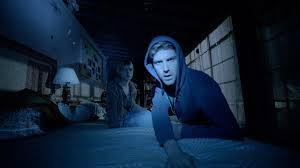
And yet—spoiler alert—it's not. No, Mr. Jones is something a lot more ambitious; and since I'd like to get the unpleasant part out of the way, let's go ahead and say it's not half as successful.
The film tells the story of Scott (Jon Foster) and Penny (Sarah Jones), a couple who decide to sell all their belongings, buy some nice camera equipment, and move to the middle of nowhere, ostensibly so Scott can film a "nature documentary" (yes, it's left that vague). Instead, Scott, who goes off his meds (again, precisely what "meds" is left unclear) when they move, lounges around, lazy and uninspired, and feeling as though he's made a terrible mistake. However, after almost two months they stumble upon a nearby cabin, which seems to house the artwork of a notoriously reclusive but world-renowned artist (I guess Banksy would be the closest comparison? Don't worry, that's exactly the comparison they make in the film, although J.D. Salinger might be a more fitting analogy). Soon, they've decided to make a film about the fact that they've happened upon the art world's most famous recluse. Scott flies to New York to interview experts on this great talent, and Penny begins filming all the odd scarecrows and artworks that he has posted nearby. However, it soon seems that there is something more to both the artist and his art; Scott decides to venture back into his cabin to document his workspace, and soon enough Penny and Scott are running for their lives, as something unholy is loosed upon them in the woods.
Look, spoilers from here on out, because there's just no way a film like this can be intelligently discussed without going into the very thing that makes it unique. It would be like trying to debate the merits of Cabin In The Woods without acknowledging the third act—it doesn't help anyone. So, the question: do you watch it? I'm going to say yes, with reservations. It's not a good movie. I can't really get around that. But it's so interesting, and filled with so much potential, that I can't help but encourage horror fans to weigh in with their own opinions. There's a reason it was incredibly divisive when it premiered at Tribeca. Ultimately, I think the reasons people love it and hate it are bound up together intimately, and I'm going to make the case that the former need not have been hamstrung by the latter. But here endeth the spoiler warning.
SO. What happens, of course, is that Mr. Jones, the reclusive artist, turns out to not be a threatening figure, but rather the gatekeeper and protector, standing between us and the nasty creatures of the netherworld. (As one of the "professors" interviewed says, he is the soul that manages to walk in both our world and the shadow world, keeping the demons from entering through.) Thus, when Scott ever-so-smartly decides to steal one of his totems while filming in the catacombs beneath Mr. Jones' cabin, it unleashes a shitshow. We soon realize that upending Mr. Jones' protections has trapped Penny and Scott in the shadow world (which, if they hadn't gotten the memo already, becomes pretty clear when the sun NEVER RISES the following day). They then are hunted by their evil doppelgangers—the nightmare versions of themselves, I'd venture to guess, though the film leaves everything ambiguous—until Scott makes the move to return the totem from whence he stole it. Of course, at this point Mr. Jones has already been taken (killed?) by the evil spirits, so when the film ends, it's fairly clear that Scott is expected to remain behind, forever stuck as the new Mr. Jones, fighting off the creatures from the shadow world.
It sounds pretty simple when I explain it like that, doesn't it? Let me assure you, the film takes the most arduous roundabout route to get where it's going. Here's the thing: there is so much that's GOOD about the film, it's almost astounding that it ends up whiffing so badly. The good starts with the cast: Sarah Jones and Jon Foster are both superb, smart actors with soul and wit. They embody their characters with an appealing charisma that manages to transcend some of the more inexplicable actions we're expected to swallow. Jones, in particular, makes every moment with Penny a delight, as she captures the conflicted frustration of someone who has cast her lot with a person that may not be the most reliable of sorts. She was good in Alcatraz—the short-lived J.J. Abrams show—but she's superlative here.
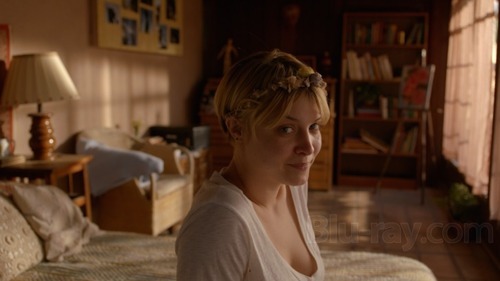
Also, the ideas behind this film? Spot on. The notion of an artist whose bleak, disturbing pieces actually function as a means of preventing real darkness is an underdeveloped theme in much horror, so to see it approached head-on is refreshing. There's the suggestion that mental illness, depression, all manner of real-life maladies, are actually helped by an engagement with arts and ideas many people find disturbing, and the cerebral take on the material at play in this movie carries it a long way, almost to the end. But not quite. Ahem.
Rarely have I seen cinematography so strong, so evocative, so effective, crippled by the woeful editing and directing choices of someone with an overcooked sense of artistry and an undercooked sense of what makes a film work. First of all, let's talk about the effort to transcend the found footage conceit, the last refuge of the scoundrel. It rarely bothers me when people pull the "but who edited this footage?" card, as found footage movies are often edited sensibly enough to give the impression of just being the consecutive moments captured by whoever was filming, no matter how implausible it seems. But Mr. Jones wants to have it both ways: it tries to embrace the tactic in its first half, before purposefully jettisoning it (for narrative reasons) in the second half. Unfortunately, by then, it had already completely fucked whatever hope it had of appearing "found footage." It's weirdly, abruptly edited; some scenes make no sense as being filmed, by anyone; and the pacing and editing suggest it was heavily edited by our protagonist, when, by the end of the film, we see that would be impossible. So, on a very fundamental level, the film already shoots itself in the foot.
But. I want to give credit where credit's due. The movie genuinely tries to revise itself, mid-film, by suggesting that what we are seeing could come from anywhere, at any point. There's an omniscient narrator, who has been filming all along, and when our characters realize this, it pushes them one step closer to realizing the nightmare they've fallen into. If only it could have been conveyed in a coherent way, this movie could've been something special. (Samuel Zimmerman's Fangoria review points out the obvious comparisons to Resolution, and while he's a bit nicer about the analogy, it only makes Mr. Jones look all the worse by contrast.)
See, the film ends up devolving into incoherence. But not just a failing of spatial geography or time frames; Mr. Jones turns into a poorly assembled mish-mash of lovingly constructed shots and scenes. It started to make me angry after awhile: "Such spectacular visuals being hacked to death?" It filled me with a sense of rage that was probably second only to the rage felt by the cinematographer when he saw what had been done to his images. The movie ends up jumbling everything around, in an effort to mirror what the characters are experiencing, but which ends up just being a total loss. The screen cuts to black so many times, and for so little reason, I started playing a drinking game with my club soda, only to empty the bottle after about 20 minutes. It's that bad. There becomes so little rhyme or reason to the edits, I felt like the director was playing a game of seeing just how much of an art-school fuck-off he could get away with.
Only, I know that's not the case. Karl Mueller wrote the solid horror thriller The Divide, and even though this is his directorial debut, you get the sense he was really trying to blow your fucking mind with his little movie. Unfortunately, like so many beginner directors before him, Mueller has confused abundance with artistry. He's so eager to dazzle you with his many wonderful shots, he never stops to let you feel a tone, or mood, or actually, you know, get scared—presumably the point of this whole endeavor. There are so many damn montages, and cuts while the sound continues, and cuts to black meant to set a mood, that it eventually becomes clear that this movie wasn't assembled by anyone, there is no found footage, and no reason for many of the shots, beyond the notion that they looked pretty cool. A shot of coffee creamer spreading through a mug just made me angry, once I realized how extraneous to the film it was. (Again, there's a halfhearted effort to explain these shots because Penny is shooting them, and she's a "photographer," but not really.)
There's another scene where it seems as though Mr. Jones has killed Penny. But then it turns out he hasn't? But maybe he has? And another scene where Scott starts calling out to Penny, even though he knows she's nowhere nearby? Oh, and a scene where they whisper all the dialogue to each other, for no discernible reason? Ugh. I can feel my anger rising again.
Look, I know it feels like I'm being unnecessarily harsh on this film. But longtime readers know I wouldn't spend all this time sorting out my thoughts if I didn't think there was some greatness buried here. And there is—that's what so frustrating about the film. As I've said, it's a genuinely great story, there are some wonderful performances, it looks absolutely gorgeous (seriously, hire this cinematographer, Mathew Rudenberg, everyone), and so many of the shots are composed with a smart eye. But, God damn it, the film has been edited into mud. It's stressful to see so much greatness muddled into fuzz, like mint leaves ground into a julep. Mr. Jones has so many wonderful elements, I want to see it succeed. I hope Mr. Mueller learns from his mistakes on this film—he obviously has tremendous talent, and I look forward to his next movie. Consider Mr. Jones a botched trial run; it's the filmic equivalent of everything going right except for one little niggling problem that ruins all else.
#Something Booo#Horror#Mr. Jones#mathew rudenberg#Sarah Jones#Jon Foster#Resolution#found footage#bummers
1 note
·
View note
Text
Review: The Babadook (Australia, 2014)
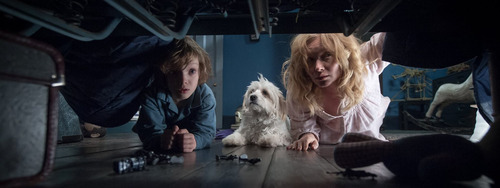
One of the great things about The Babadook is that you immediately notice the painterly quality of the film. It's got that wonderfully composed look, as though it were a part of the very children's book that makes up the backbone of the story. Every shot feels less like a camera image, and more like a glimpse into a hand-drawn storybook blown up to maximum size.
The Babadook, if you're unfamiliar with the title, is this year's horror film du jour, for those who keep track of that kind of thing. Since its first appearance in the early film festivals in the States, it's been garnering the kinds of raves and reviews that normally signify a movie with the potential to break out of the indie horror ghetto and into the mainstream. Of course, normally that tends to mean something teenagers can latch onto and watch over and over on a Saturday night sleepover, and The Babadook isn't really that kind of horror. Instead, it's a slow burn type of film - scares aplenty, but delivered in the kind of stately, measured pace which doesn't exactly reel in the crowds. There's no big "gotcha" ending, no final twist of the knife, hardly a jump scare to be found. This isn't to say that the whole thing works (more on that later), but when it works, it really, really works. (It does leave me wondering whether, in this day and age, had The Exorcist come out now instead of the '70s, it would still achieve the type of massive cultural penetration that it did.)
The Babadook tells the story of Amelia (Essie Davis, crushing it) a woman who lost her husband in a car accident the day her son Samuel (Noah Wiseman) was born. She's now working as a hospice care provider for the elderly, and doing her best to raise her son despite what seem to be some fairly severe behavioral problems on his part - aggressive behavior, acting out in willful and unpredictable ways, plagued constantly by nightmares that keep him - and by extension, Ameila - up all night. She seems to struggle through, despite the grogginess and sleep deprivation, until one night when her son pulls a strange book off the shelf, called Mister Babadook, and asks her to read it to him. It's a picture book, about a mysterious creature that announces its presence by knocking three times, and can't be gotten rid of once it's let in. The pictures immediately disturb Sam, and the book's creepy overtones (once the Babadook is in, you'll "wish that you were dead"), leads Amelia to hide it from her son. To no avail: he begins having nightmares about the Babadook, and even after she hides it, he continues to insist the creature is real, even disturbing Amelia's sister Claire and her daughter.
However, soon Amelia wakes up to the sound of three knocks, right outside her door. From that moment, she begins to question whether the Babadook might actually be real. She begins experiencing visions, seeing things she can't believe are there, and wondering if this mysterious monster could really be at the heart of it all.
Genuinely unnerving, the film is executed with a deft touch. Writer-director Jennifer Kent knows when to let a scene breathe, and when to ramp up the tension. Best of all, she manages that most difficult of horror tricks, moving a single shot from innocuous to sinister through nothing more than a well-done sound edit. There's an early scene where Sam is lying in bed with her, depicting the difficult yet intimate bond between the two, and with only a slight shift of the background noise, we move from a sense of familial comfort to one of threatening uncertainty. The best compliment I can think of to pay the film is that it uses sound the way that The Conjuring used spatial geography.
But there's endless homilies online to how well-constructed and scary the film is—you don't have to look far to find them. So let's talk about what the film is about, because it's one of the main reasons it's achieving such high marks from critics and fans alike. I would posit that one of the primary causes for the film's overwhelmingly positive reception is the rich symbolic emotional themes at work in the film. To wit: perform the standard analytic trick with horror of removing the supernatural element, and whatever is left is what the film is really about. Unlike most movies, The Babadook resists easy interpretation, partially because the film itself is about the fine line between the supernatural and the psychological. It's clearly meant to be an open question whether the Babadook is real, or merely a figment of Amelia's sleep-deprived mind. Each time she interacts with the outside world, be it her concerned sister questioning her judgment and mental stability or the bored police officer skeptically listening to her story of a threatening children's book, it's hammered home that all of this may be in her troubled mind. We see the world of the film through Amelia's point of view, and so her fears are our fears.
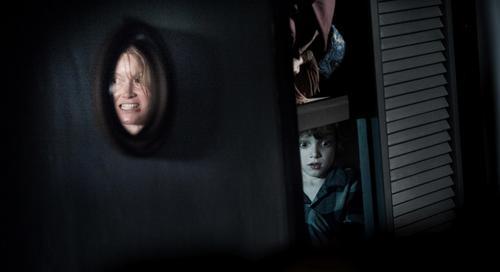
More interesting still, her son is not only the troubled source of some of her problems, he also seems to reinforce the horrific reality of the Babadook. In this sense, the film actually closely resembles William Friedkin's latter-day masterpiece Bug. Whereas in that film the force of Michael Shannon's psychosis slowly causes Ashley Judd to embrace his unstable worldview with the conviction of a brainwashed cult member, here there is almost a feedback loop between Sam and Amelia: his childhood fears manifest as her adult nightmares, which in turn lends more credence to Sam's own fears, in a spiraling dervish of shared hallucinations.
Thus, the Babadook can arguably function as the stand-in for a number of all too real nightmares. At times, it seems to be the manifestation of Amelia's mental illness, a monster that, once it appears, can never truly be gotten rid of. It comes and goes, much as real-life mental illness can be suppressed or released with varying degrees of control or awareness. In other ways, it seems to be the representation of grief itself; Amelia has suffered a traumatic loss with her husband's death, and rather than process it, she has hidden it away (quite literally, with the basement of the house containing all memories of her dead spouse). Thus, by this account she has a form of PTSD, and the refusal to engage with her loss is slowly building up the trauma, until it unleashes to horrifying effect.
But there's also an argument to be made for something quite different, a reading that I am quite enamoured of the more I think about it: The Babadook isn't Amelia's illness, it's Sam's. The whole film is not from Amelia's point of view, but rather Sam's—how he perceives his mother's perspective of what is happening. His troubled mind can nonetheless realize the resentment she feels towards him, as well as her difficulty dealing with her husband's death, and the psychic pain of the situation manifests itself via his ultimate fear: that his mother can literally stop being his mother, could become someone else. Freud explained this in his example of the child who receives a toy truck from his parents, and even though he may not particularly like the present himself, he sees their expectations, and thus performs the act of playing with the truck. The enjoyment from the act of playing with the truck is theirs, not his. In this reading, The Babadook is the psycholigical performance of Sam's fears for his mother's benefit—the idea that his fears are real, that her mental illness and troubled life are not her fault, nor Sam's, but rather the monster that they must conquer and ultimately accept in their lives.
The Babadook isn't always successful; at times, the special effects detract from the psychological effectiveness of the whole. There are some nice comic moments that serve to inject some much-needed lightness to the events of the film, but there are also some overly dramatic beats that actually seem a bit florid and ill-fitting to the reality of the cinematic world of the movie. Nonetheless, it's a remarkable accomplishment; the fact that it seems so simple masks the achievement of the movie. For once, the consensus is spot-on: this is the horror achievement of the year, and its faults are forgivable in the face of how well it does what it sets out to do. See this film.
#something booo#horror#the babadook#jennifer kent#essie davis#william friedkin#bug#psychological horror
1 note
·
View note
Text
New trailer for THE WELL
Here's the new international trailer for Tom Hammock's post-apocalyptic thriller THE WELL. It looks a bit like a reworking of ASSAULT ON PRECINCT 13, but with the environmental angle in place of a prisoner. Still, could be fun, and there's some talent both behind and in front of the camera.
THE WELL stars Haley Lu Richardson, Booboo Stewart (Twilight), Jon Gries (Taken), Nicole Fox (“America’s Next Top Model”), Michael McCartney (The Amazing Spider-Man), Michael Welch (Twilight), Rena Owen, Max Charles (The Amazing Spider-Man), Jacqueline Emerson (The Hunger Games), Barbara Crampton (Re-Animator), and Michael Massee (Seven).
0 notes
Text
Review: Deliver Us From Evil (USA, 2014)

You get the sense, watching Deliver Us From Evil, that director Scott Derrickson really, really wanted to make an exorcism movie for the ages. You don't end your film with a nearly twenty minute long scene of an exorcism unless you're trying to compete with the grandaddy of them all. The Exorcist is still the alpha and omega of cinema when it comes to that particular subgenre, and even films that have attempted to enter that rarefied air over the years - The Exorcism of Emily Rose, The Last Exorcism, The Rite - tend to go into it with a feeling that, at best, they can provide a supplementary experience (or in the case of The Last Exorcism, a smart meta-comment on the genre itself).
Deliver Us From Evil, on the other hand, has ambition to burn. Coming in at nearly two hours, the movie acts as a mash-up of exorcism and cop drama, with the tropes of the conflicted law enforcement hero who neglects his family splashed liberally throughout the film. The short version of this review would simply observe that Derrickson is on sure footing when it comes to the scares, and much more uneven when it comes to the prosaic human foibles aspect of the story. But that's not the most interesting part of the film. For that, we need to look at what makes good horror into great horror.
The plot revolves around NYPD detective Ralph Sarchie (Eric Bana), your prototypical "puts the job first" movie cop. He has a loving wife and daughter who want more of his time and affection, but all Sarchie seems to focus on is the job, which, as we pick up his story, shows up him failing to revive a dead infant left in a dumpster. Not exactly a cheery introduction; the film wants us to feel both Sarchie's exhaustion and his drive to set things right, and it tries to do so by wallowing in the ugly side of his work. It's a bit much, but it gets across what it intends. A new case, however, tests Sarchie's resolve. A domestic violence call, a mother who kills her own child, and a missing painter all turn out to be connected, through a discovery of ancient text that seems to cause madness in everyone who comes across it. Soon, Sarchie is hearing things, having hallucinations, and is approached by a Catholic priest (Edgar Ramirez) who tells him that the problem is mystical - demonic possession of vulnerable souls. His initial scorn soon turns to belief, and without further ado Sarchie, the priest, and Sarchie's adrenaline-junkie partner (we know this because the film somewhat clumsily calls out this character trait, as it does most character traits throughout the film) are on the hunt for the ringleader of this possession "infection." Needless to say, things eventually come to a head.
The film has the admirable quality of constantly trying to elevate its often pedestrian source material. A number of shots, especially in the early going, possess striking composition, making the gnarly world of gutter-scavenging police work look much more elegant than it is. Derrickson, the director of 2012's superior Sinister, still has a way with jump scares; the first half of the film manages almost a half-dozen such moments effectively, never feeling cheap or exploitative in their usage. Also, the climactic exorcism has a number of well-done moments, beats that elevate the pulse even if they don't exactly chill the blood. The man has a genuine talent for horror, and it's a skill that shouldn't be undervalued - God knows how many otherwise-talented directors have dropped the ball when it comes to injecting scares into their projects. (See: Mike Nichols' Wolf. Or better yet, don't.) His ability is on full display here, with scenes of wordless mystery recurring throughout. Sarchie's explorations of mysterious basements, the daughter's confrontations with an inexplicable sound - there is a fleet and entertaining horror film here, that periodically pops its head up and makes the whole thing fun.
However, that film would be a good twenty minutes shorter. Whereas the talent in creating horror lies precisely in creating out of whole cloth tension and mood that doesn't exist on the printed page, nothing hamstrings drama quicker than a dreadful script. Human relations need believable human emotion, and when people are spouting cliches, such relatability quickly goes out the window. Unfortunately, this is the problem that confronts the rest of this overlong movie. Every time we return to the listless, uninspired cop drama that is fused onto the skeleton of a much more fun horror flick, Derrickson loses the tempo. We're pulled from the acceptably farfetched nature of a supernatural thriller and dragged into an unacceptably farfetched world of rote speechifying and reductive character beats. Joel McHale's jacked-up partner role might as well be called "Comic relief cannon fodder." Olivia Munn's long-suffering wife, the name "Cop Drama Long-Suffering Wife #72." And so on. With a quicker pace and tightened story, this might be more ignorable. But at two hours, it feels ponderous.
Ironically, this causes some of the horror scenes to blow by much too quickly. All the other stuff crammed in means less time to build up tension in the scenes with scares. The moments where frights pop up occasionally zip by too fast to be really effective. A pre-opening credits scene in Iraq held out real possibility, until it flew past. A potentially creepy basement confrontation turns into an MMA-style rumble, leaving us far too much time to ponder why Joel McHale feels the need to take on an ax-wielding maniac with a knife, rather than his goddamn revolver. (Spoiler alert: that doesn't end well for him.)
But ultimately, I have to applaud Derrickson for his bravura (if only fitfully successful) exorcism scene. He takes plenty of time to linger here, clearly doing his best to give us something we haven't seen before. And he's successful, in part. There are some wonderfully inventive and engaging moments in the climax, including our possessed man gnawing chunks out of his own leg. It manages to add some innovations to what is ultimately just two guys yelling Latin at another guy strapped to a chair. It's tough to make that compelling, this many years after William Friedkin's masterpiece. A few moments really don't stick the landing: the decision to use snippets of music by The Doors as a symptom of the demon's assault is particularly awkward, though it does hilariously imply that Jim Morrison made music so painful to the human ear it will literally let evil into the world.
By the surprisingly happy ending (to some extent I suspect the problems of structure are the result of sticking to the source material; the real-life Sarchie's book likely makes some of this stuff more understandable), we feel relief that there's no further scenes to drag this out. It's had some good moments, but you can't shake the feeling that there's a lot of dross that could be stripped from this enterprise, to much more satisfying results.
Taking a film on its own terms means confronting the terms that fail to achieve their goals. One could obviously envision a way to make all this work, too, but by the end, we've lost the motivation to try. Making good horror great means that all the stuff that has nothing to do with scares has to soar as well; here, despite solid performances by nearly everyone and a good-looking product, too much of the material is a drag to really endorse it. This would be a perfectly fun movie to stumble across when lying on the couch some Sunday afternoon; sadly, it can't help but feel like too much of the filler, not enough of the killer. I give this movie six out of ten Latin recitations and four out of seven sprinklings of holy water.
#something booo#horror#Deliver Us From Evil#Scott Derrickson#Eric Bana#Olivia Munn#The Exorcist#william friedkin#The Last Exorcism#the exorcism of emily rose#halfway fun
1 note
·
View note

